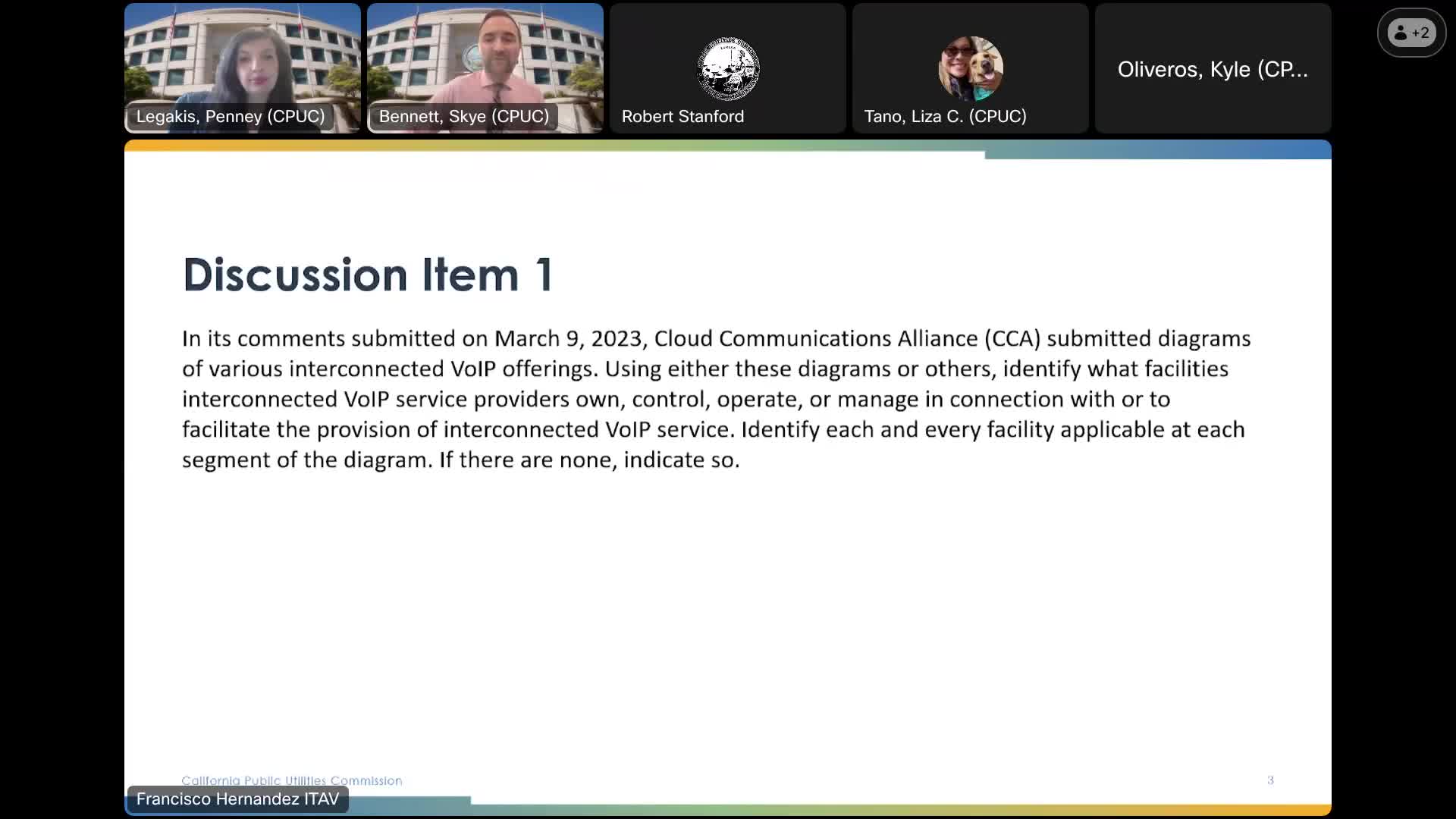Cloud Communications Alliance outlines VoIP network distinctions at industry workshop
June 05, 2025 | California Public Utilities Commission, Boards and Commissions, Executive, California
This article was created by AI summarizing key points discussed. AI makes mistakes, so for full details and context, please refer to the video of the full meeting. Please report any errors so we can fix them. Report an error »

In a recent technical workshop hosted by the California Public Utilities Commission, industry leaders gathered to discuss the nuances of Voice over Internet Protocol (VoIP) services and the regulatory landscape surrounding them. The meeting, held on June 5, 2025, featured representatives from various companies, including Comcast and the Cloud Communications Alliance, who shared insights on the definitions and distinctions between network facilities and equipment.
As the discussion unfolded, Jonathan Marashlian from the Cloud Communications Alliance emphasized the importance of differentiating between "facilities" and "equipment." He clarified that facilities refer specifically to the last-mile connectivity that physically reaches customer premises, while equipment encompasses the various devices and technologies that operate over these networks. This distinction is crucial for understanding regulatory requirements, particularly as they pertain to licensing and authority for VoIP services.
Suzanne Toler, representing Comcast, echoed this sentiment, noting that voice services are delivered over broadband networks, which integrate voice, data, and video packets. She argued that Comcast's existing authority under its Digital Infrastructure and Video Competition Act (DIVCA) franchise negates the need for additional regulatory approvals for its VoIP services. This point sparked further dialogue about the implications for other VoIP providers who do not own the last-mile facilities.
Mark Iannuzzi from Telnet reinforced the idea that the diagrams presented during the workshop were intended to illustrate typical components of a VoIP network rather than specific configurations. He reiterated that the backbone of VoIP services relies on robust broadband networks, underscoring the collaborative nature of modern telecommunications.
The conversation also touched on the regulatory framework, with participants discussing the California Environmental Quality Act (CEQA) and its relevance to the definition of facilities. Toler pointed out that the act is concerned with physical disturbances to the environment, aligning with the notion that facilities involve tangible infrastructure.
As the workshop progressed, questions arose about the technical aspects of network operations. Participants expressed a desire for more detailed explanations regarding the equipment used in VoIP networks and how these systems interface with traditional telephony networks. The call for input from network engineers highlighted the complexity of the topic and the need for clarity in understanding the operational dynamics of VoIP services.
In conclusion, the workshop served as a platform for industry stakeholders to clarify their positions on the regulatory landscape of VoIP services. With ongoing discussions about the definitions of facilities and equipment, the implications for licensing, and the technical intricacies of network operations, the dialogue is set to continue as California navigates the evolving telecommunications landscape.
As the discussion unfolded, Jonathan Marashlian from the Cloud Communications Alliance emphasized the importance of differentiating between "facilities" and "equipment." He clarified that facilities refer specifically to the last-mile connectivity that physically reaches customer premises, while equipment encompasses the various devices and technologies that operate over these networks. This distinction is crucial for understanding regulatory requirements, particularly as they pertain to licensing and authority for VoIP services.
Suzanne Toler, representing Comcast, echoed this sentiment, noting that voice services are delivered over broadband networks, which integrate voice, data, and video packets. She argued that Comcast's existing authority under its Digital Infrastructure and Video Competition Act (DIVCA) franchise negates the need for additional regulatory approvals for its VoIP services. This point sparked further dialogue about the implications for other VoIP providers who do not own the last-mile facilities.
Mark Iannuzzi from Telnet reinforced the idea that the diagrams presented during the workshop were intended to illustrate typical components of a VoIP network rather than specific configurations. He reiterated that the backbone of VoIP services relies on robust broadband networks, underscoring the collaborative nature of modern telecommunications.
The conversation also touched on the regulatory framework, with participants discussing the California Environmental Quality Act (CEQA) and its relevance to the definition of facilities. Toler pointed out that the act is concerned with physical disturbances to the environment, aligning with the notion that facilities involve tangible infrastructure.
As the workshop progressed, questions arose about the technical aspects of network operations. Participants expressed a desire for more detailed explanations regarding the equipment used in VoIP networks and how these systems interface with traditional telephony networks. The call for input from network engineers highlighted the complexity of the topic and the need for clarity in understanding the operational dynamics of VoIP services.
In conclusion, the workshop served as a platform for industry stakeholders to clarify their positions on the regulatory landscape of VoIP services. With ongoing discussions about the definitions of facilities and equipment, the implications for licensing, and the technical intricacies of network operations, the dialogue is set to continue as California navigates the evolving telecommunications landscape.
View full meeting
This article is based on a recent meeting—watch the full video and explore the complete transcript for deeper insights into the discussion.
View full meeting
